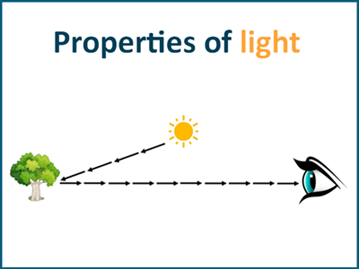What is light made of?
Light has no mass and it’s not considered matter. Light is a form of energy made of photons. It’s unique in that it behaves like both a wave and a particle.
For us to see, there must be light. Light shines on an object and bounces off, or reflects, back to our eyes. Our eyes can see what we call visible light. Visible light is all the colors (green, blue, yellow, red, etc.) that we can see.

There are other kinds of light that the human eye cannot see, such as ultraviolet light. Some animals, like bees can see ultraviolet light.
Why does light go through some things and not other things?
Light behaves differently depending on what type of matter it meets. Light will pass through some matter such as air or water. This type of matter is called transparent. Other objects reflect light, such as a tree or a car. This type of matter is called opaque. Some objects does some of both and scatter the light, such as frosted glass or a stain glass window. This type of matter is called translucent.
In our grade 1 energy section, there are several worksheets for students to practice light.
Practice light and dark
The first thing students in grade 1 learn about light is how light affects how we see objects. Basically, that we need light to be able to see things.
Transparency worksheets
Students identify objects which light can pass through in these worksheets.
Practice light rays
Students are asked to draw lines from the sun to the object and onto the eye to learn how light bounces off objects for us to see them.
Learn about shadows
Depending on the direction of the sun the shadow of an object appears in a straight line from the sun to behind that object. Students learn that light travels in straight lines in these worksheets.





